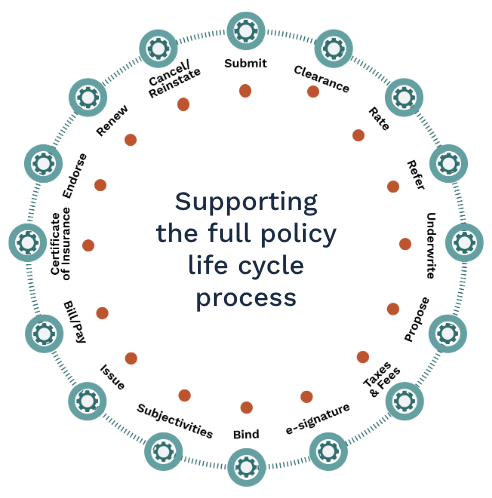Despite the myriad of changes affecting the industry, speed to market remains a priority for insurance carriers.
The faster you’re able to launch new products and implement changes to existing ones, the better you’re able to seize new opportunities and make revenue-saving adjustments.
But insurers can only move as fast as their technology allows them. At Solartis, we’ve heard from many organizations who understand the need for speed to market but are bogged down by legacy systems.
The best path forward is to adopt low-code tools that enable more rapid product launches and lower IT costs. Low-code development has already gained significant traction in other industries, and insurers who want to keep pace with consumer expectations should follow suit.
What Does Low-Code Mean?
Low-code is an approach to software development that employs a graphical user interface rather than a line-by-line code editor. As a result, applications are built by combining components in an environment that’s more inviting for non-technical employees to use and manage.
Low-code differs from no-code in that these tools are structured to allow custom code to be incorporated into the areas that require more technical prowess. In contrast, no-code apps are structured so that users don’t need to add custom code at any point.
However, no-code systems tend not to work well for core insurance policy administration systems because of the technical requirements of working on these platforms. No-code solutions are typically better fits for simpler type applications.
The Benefits of Adopting Low-Code Solutions for Insurance
1. Get Products to Market Faster
The most immediate benefit of deploying low-code tools is getting insurance products to market faster. Since low-code tools reduce the amount of code that needs to be written, developers alongside business analysts can build, QA, and launch products more quickly.
More specifically, most low-code builders enable developers and business analysts to construct applications without building every component from the ground up. When it's necessary to write new code, developers can easily add it to what they’ve built within the tool itself.
This change in workflow can deliver profound benefits. An MGA in Canada launched 25 new products in 12 months using a low-code platform and grew their revenue exponentially. 1
2. Lower Your Cost of Ownership
Traditionally, as your portfolio of digital products grows, so does the team that manages the technical backend. Unfortunately, hiring developers is very expensive, and growing your development team can substantially raise the cost of ownership of your tech stack.
Low-code tools not only speed up the deployment of new insurance products but also make maintenance easier. Since there’s less complexity, less coding needs to be done, so you’ll need fewer in-house developers to manage your portfolio, which can lead to significant cost savings.
Moreover, the intuitive nature of low-code tools allows employees without deep technical expertise to contribute to insurance product management.
With a low-code platform, non-technical users can now create and edit:
- Coverages
- Rate table
- Look-up tables (valid values)
- Document and policy form management
- UI/UX (screen) questions management
- Rules management
- Notifications
- Rating Algorithms
Often called citizen developers, these power users and business technologists can drive cost reductions too by performing these tasks traditionally reserved for developers.
3. Improved Business Agility
Becoming a more agile business means getting better at understanding and reacting to shifts in the market. These shifts could be customer sentiment, regulatory changes, or macroeconomic factors.
Regardless of the particular source of the change, businesses that adjust faster than their peers can turn market changes into opportunities.
This is yet another area where low-code software can benefit insurers. The reduced development time and democratization of work enabled by low-code tools empower business units across the organization to respond quickly to local and national shifts in the insurance market.
Research has found that implementing low-code tools can make product development up to 50% faster.2
4. Seamless Integration with APIs
Insurance APIs are the connective tissue of modern policy administration systems. They transport value data and power mission-critical functions throughout the complex systems that insurers rely on.
Good low-code tools must be configured to integrate with proprietary and third-party APIs. That means insurers can adopt these applications without having to do significant work to their core systems.
Integrating with APIs also empowers insurers to add new features, create workflows, or even launch entirely new products without adjusting the underlying infrastructure. Even organizations on monolithic systems can benefit from low-code products because they can integrate with whatever insurance APIs are connected to the legacy infrastructure.
5. Collaboration and Activation of Non-Technical Users
There’s a shortage of IT personnel across most sectors. The demand for skilled developers may be higher than ever, but the talent supply simply isn’t there. 24% of insurance leaders said bridging the talent gap was their biggest priority for 2024.3
Insurers also feel this shortage, but low-code technology can offer a viable solution. Because low-code systems make designing and building insurance products simpler, non-developer users can participate in the construction of these products. This can deliver noticeable benefits for the entire organization.
First, making developers more efficient and effective. Rather than handling every single issue, they can focus on the high-priority matters that have the biggest impact and truly require their technical expertise.
Second, low-code software allows users outside the development team (citizen developers, specifically) to resolve issues or make changes quickly based on customer feedback. Consequently, the entire process of shipping updates becomes faster across insurance organizations.
6. Better Regulatory Compliance
It’s no secret that Insurance carriers are under constant scrutiny to comply with regulations. Compliance is an ongoing initiative—not a one-time project. Security, privacy, and a host of other considerations all inform the tenets of a solid compliance program.
But when the time comes to make changes—where on the front end for customers or on the back end for technical considerations—low-code platforms allow insurers to make the necessary changes faster than a traditional development approach.
Bringing Low-Code Tools to Your Business with Solartis
Solartis Builder is the low-code toolkit of choice for insurers and MGAs that need to revolutionize how they develop and maintain products.
Easily create and manage personal and commercial insurance products with our microservices architecture and Low-code toolkit. Make non-technical users like, subject matter experts, business analysts, and actuarial and regulatory a part of product management.
With Solartis Builder (our low code toolkit), you can create, test, and deploy product changes without any assistance from DevOps, expediting the entire product management process.
Contact us to learn how Solartis Builder can improve your organization’s speed to market.
Sources
1 https://insurtechdigital.com/articles/no-code-and-low-code-platforms-in-the-insurance-industry
2 https://www.redhat.com/cms/managed-files/mi-451-research-intelligent-process-automation-analyst-paper-f11434-201802.pdf
3 https://www.wtwco.com/en-gb/news/2023/11/insurers-predict-interest-rates-bridging-the-talent-gap-and-digital-transformation






